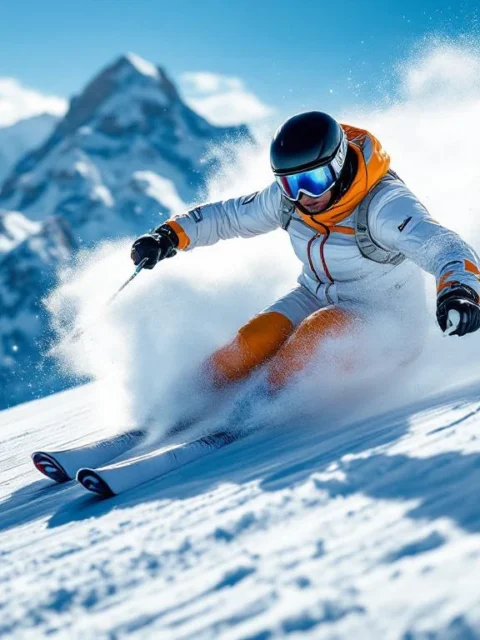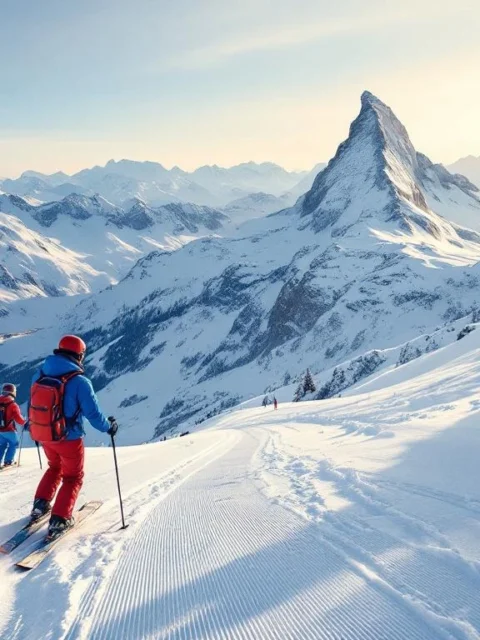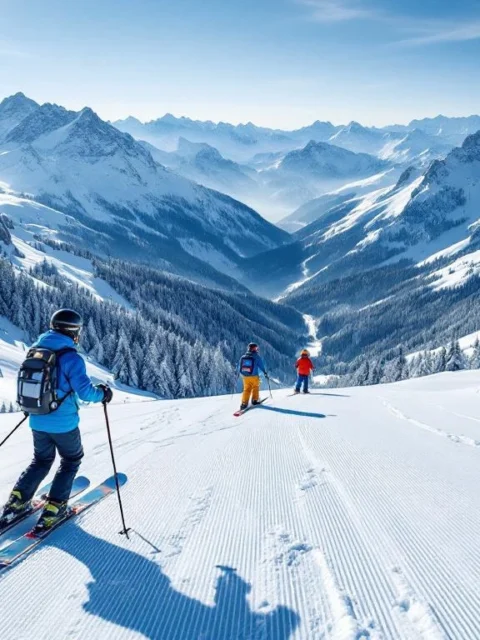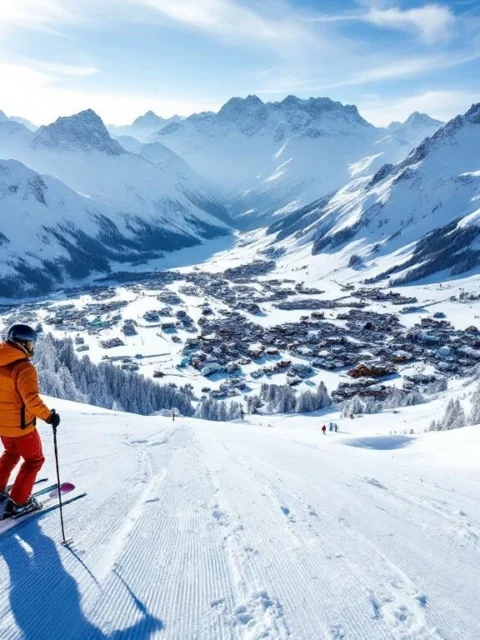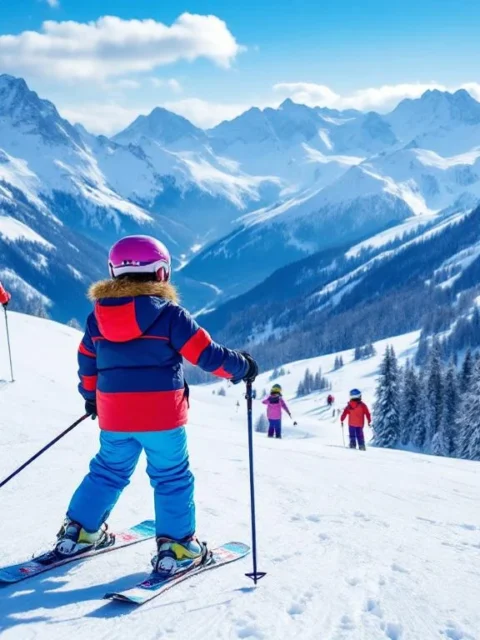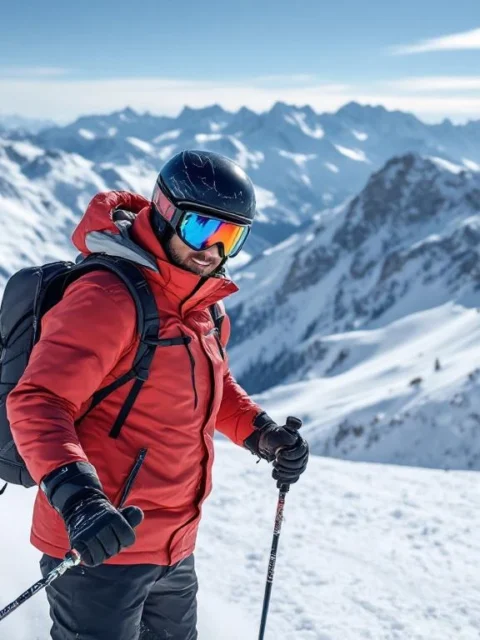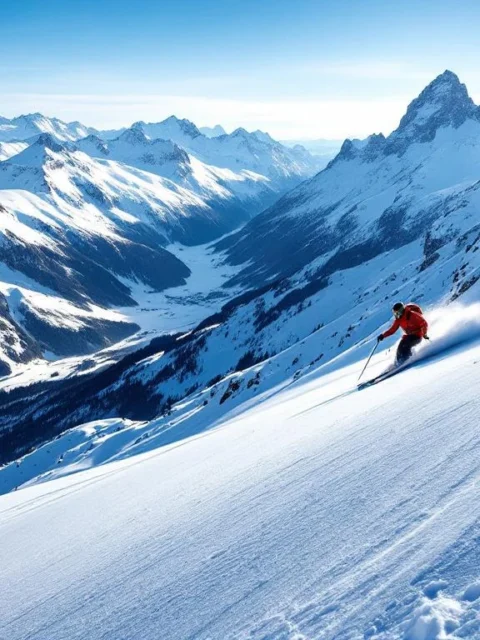How Do You Learn to Fall Safely While Skiing?
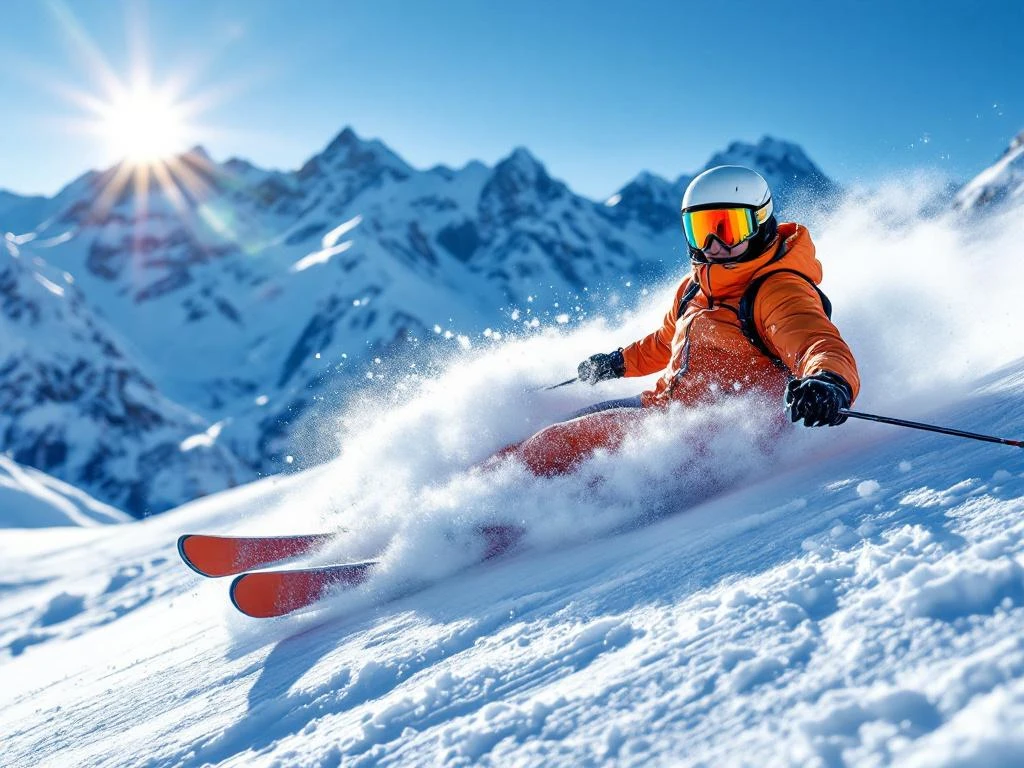
Falling while skiing happens to every winter sports enthusiast sooner or later. Whether you’re a beginner taking your first steps on the slope or an experienced skier facing a new challenge, the possibility of falling is always present. But did you know that techniques exist for falling safely? With the right knowledge, you can significantly reduce the risk of injuries. In this article, we share practical tips and techniques to help you fall safely while skiing. From the correct body posture to specific exercises, we cover everything you need to know to make falling on the slopes safer.
The Correct Posture When Falling on the Ski Slope
The way you fall can make the difference between getting up with a smile or visiting the medical station. One of the most important principles when falling on the slopes is to relax your body. Tense muscles increase the chance of injuries.
If you feel yourself starting to fall, don’t desperately try to remain upright. Instead, accept the fall and make your body small. Bring your arms to your chest and bend your knees. This posture protects your joints and reduces the impact of the fall.
You should adapt your falling technique on different types of terrain:
Falling on Flat Terrain
On flat sections, it’s important to keep your weight low. Bend your knees as soon as you notice you’re losing balance. Try to fall to your side rather than forward or backward. This reduces pressure on your wrists and knees.
Keep your arms close to your body, with your hands near your shoulders. This prevents you from instinctively extending your arms to break your fall, which often results in wrist or shoulder injuries.
Falling on Steep Slopes
On steeper slopes, it’s important not to resist the fall. Let your body go with the movement and try to roll onto your side. Keep your skis up, away from the snow, to prevent them from catching and causing a twist in your knees or ankles.
If you fall on a steep slope, keep your ski poles close to your body rather than extended, to prevent them from getting caught on something while you slide.
Protection of Vulnerable Body Parts
Your head, wrists, and knees are especially vulnerable during a fall. That’s why a ski helmet is not an unnecessary luxury. For your wrists, it’s important not to use them to catch your fall. If you instinctively extend your hands, try to keep your palms open and avoid landing on your fists.
For your knees: try to keep them slightly bent during a fall. A fully extended knee is much more susceptible to injuries than a slightly bent knee.
Exercises for Training Controlled Falls
Before hitting the actual slopes, you can practice falling in a safe environment. This helps you develop the right reflexes for when you actually fall while skiing.
Preparatory Exercises at Home
Even at home, you can practice the basic principles of safe falling. Try this simple exercise: stand on a soft surface like a mat or carpet and slowly let yourself fall to your side. Focus on relaxing your muscles and curling your body into a ball.
You can also practice your balance by standing on one leg and wobbling slightly. This improves your sense of balance, which helps prevent falls.
Exercises on Flat Snow Terrain
Once you’re on the snow, start with exercises on a flat section. A good exercise is making small sliding movements on your skis, alternately leaning on your inner and outer edges. This helps you learn the limits of your balance.
Also try deliberately sitting down in the snow and getting up again with your skis on. This seems simple, but many beginners find it difficult to get up after a fall. By practicing this, you become familiar with the movement and build confidence.
Guided Falling Exercises During Ski Lessons
During a professional ski lesson, an instructor can help you with specific falling exercises. They can show you how to fall in a controlled manner and get up again in different situations.
A commonly used exercise is the ‘braking fall.’ In this exercise, you learn how to use your skis to reduce speed before deliberately sitting down. This is a safe way to control a fall when you feel you’re about to lose control.
Most Common Falling Mistakes and Their Consequences
Certain reactions during a fall are almost instinctive but can actually lead to injuries. By being aware of these common mistakes, you can try to avoid them.
Extending Your Arms
The most common mistake is extending your arms to break your fall. This is a natural reaction but can lead to broken wrists, dislocated shoulders, or broken collarbones. Instead, it’s better to keep your arms close to your body and roll onto your side.
If you do use your hands, try not to land on an extended arm but keep your elbows slightly bent to absorb the impact.
Staying Stiff During the Fall
Another common mistake is tensing all your muscles during a fall. By remaining stiff, you don’t absorb the impact and the chance of injuries increases. Relaxation is the key to falling safely.
Think of a judo practitioner learning to fall: they relax their body and distribute the energy of the impact over a larger surface. The same principles apply to skiing.
Resistance Against the Direction of the Fall
Many skiers instinctively try to resist the direction of the fall, which often results in awkward twisting movements and increased risk of knee injuries. Instead, it’s better to go with the fall and try to roll onto your side.
Resisting a fall also costs more energy and often results in a harder impact. By going with the movement, you make the fall smoother and safer.
Possible Injuries and Their Prevention
The most common ski injuries from falling incorrectly are:
- Wrist injuries from catching a fall with extended arms
- Knee injuries from twisting movements during a fall
- Shoulder injuries such as dislocations or torn muscles
- Head injuries from impact with hard snow or objects
Prevention starts with good preparation: ensure you’re in good physical condition, wear protective equipment such as a helmet, and take a ski lesson to learn the proper techniques.
When to Roll and When to Slide?
Depending on the situation on the slope, different falling techniques are effective. Let’s look at the two main techniques: rolling and sliding.
Rolling Technique for Shorter Falls
Rolling is usually the best choice on flatter sections or at lower speeds. With this technique, you make yourself small by pulling up your knees and keeping your arms close to your body. You then essentially roll over your side.
This technique is especially suitable when you don’t have much speed, as it helps you come to a stop quickly without sliding far. It’s also the preferred technique for beginners because it’s relatively easy to control.
Sliding Technique for Steeper Slopes
On steeper slopes or at higher speeds, the sliding technique is often safer. With this technique, you let your body go with the fall and try to slide on your side, with your skis off the snow.
The key to safe sliding is maintaining a slightly bent body posture and avoiding abrupt movements. Let your body slide until you naturally slow down or use your hands, elbows, and knees lightly to brake.
Combination of Techniques in Different Situations
In practice, you often use a combination of both techniques. For example, you can start with sliding to reduce speed and then transition to rolling to come to a stop.
The ideal technique depends on factors such as:
- The steepness of the slope
- Your speed at the moment of falling
- The snow conditions (powder snow versus icy surface)
- Obstacles in the environment
Safely Coming to a Stop After a Fall
Regardless of which falling technique you use, it’s important to come to a safe stop. If you continue to slide after a fall, try to stay on your side and use your forearms, knees, and feet lightly to brake.
On steeper slopes, you can use the ‘self-arrest’ technique: turn onto your stomach, spread your arms and legs slightly to create more resistance, and dig your toes into the snow. This technique is often used in mountaineering but is also useful when skiing on steeper slopes.
Remember that safety comes first. If you find yourself in a dangerous situation, such as sliding toward trees or a cliff, do whatever is necessary to stop, even if this means using your equipment to brake.
Getting Up After a Fall
An important part of falling is knowing how to get up again. Place your skis across the slope, push yourself up with your hands close to your body, and use your leg muscles to stand upright. If this is difficult, you can first sit on your knees before standing up completely.
The most important thing is to stay calm. Many beginners get frustrated after a fall, which leads to hasty movements and possibly more falls. Take a moment to orient yourself and check your equipment before continuing.
Falling is part of learning to ski, just like stumbling is part of learning to walk. With the right techniques, you make falling safer and significantly reduce the risk of injuries. Moreover, knowledge of falling techniques ensures you hit the slopes with more confidence, which only improves your skiing experience.
Want to improve your skiing technique and get personal advice on falling safely? Consider a lesson with one of our experienced ski instructors. They can show you exactly how to apply these techniques in practice and help you become a better and safer skier.
Frequently Asked Questions
How can I overcome my fear of falling while skiing?
Fear of falling is normal, but can limit your skiing experience. Start by practicing on flat sections where falling is safer. Wear protective equipment such as a helmet and wrist guards for extra confidence. Consider a private lesson with an instructor who can specifically work on falling techniques. By regularly practicing controlled falls in a safe environment, you build confidence and gradually reduce fear.
What should I do if I fall and my skis don't release?
If your skis don't automatically release during a fall, stay calm. First try to stop sliding by turning onto your side. Once stopped, don't bend your knees further to avoid putting extra pressure on the bindings. Use your hands to remove snow around the bindings and then press the release mechanism with your ski pole. For stubborn bindings, ask for help from another skier or ski instructor, and never force your movements to prevent injuries.
How can I prepare my body at home for safe falling while skiing?
Strengthen your core muscles with plank exercises and stability work on one leg. Improve your flexibility by regularly stretching, especially your hamstrings, quadriceps, and hip muscles. Practice balance by standing on an unstable surface (like a cushion) and making small disruptive movements. Carefully perform falling exercises on a soft surface, focusing on rolling and relaxing upon impact. This preparation makes your body more resilient and responsive during an actual fall on the slopes.
What if I fall in powder snow? Do the same techniques apply?
In powder snow, falling techniques are somewhat different. The soft snow offers more protection but also creates different challenges. Still keep your arms close to your body, but be prepared for a deeper sinking. In powder, it's crucial to keep your head above the snow to maintain visibility and breathing. The sliding technique works less effectively because powder quickly slows you down, so focus more on the rolling technique. After falling in deep powder, create a platform by compressing snow around your skis before trying to stand up.
Which specific protective equipment is most effective for preventing injuries when falling?
Besides a helmet, which is essential for head protection, there are several effective protective items. Back protectors reduce impact on your spine and are especially valuable for freestylers and children. Wrist guards help prevent common wrist injuries by stabilizing the joint. Impact shorts protect your tailbone and hips. Knee protectors are useful for skiers with previous knee problems. Choose protection that fits comfortably and doesn't restrict your freedom of movement for the best results.
How should I respond if I see another skier fall and possibly get injured?
Always stop safely if you see a fallen skier who might need help. Approach from the top of the slope and place your skis crosswise above the fallen person to warn others. First ask if they need help and assess the situation without moving the person if you suspect serious injury. Send someone to the nearest ski lift to alert the slope patrol or call the emergency number if you have reception. Stay with the injured person until help arrives and keep them warm with extra clothing if available.
What is the best way to teach children to fall safely while skiing?
Make safe falling a game for children. Start on flat terrain with making 'snow angels' to get familiar with lying in the snow. Teach them the 'pizza position' (snowplough) to control speed before falling. Practice deliberately sitting down and getting up again with skis on. Use imagery such as 'make yourself small like a ball' to clarify the concept of rolling. Always praise their courage after a fall and focus on the process of getting up and continuing. Consider group lessons specifically for children where falling techniques are often taught in a playful way.


